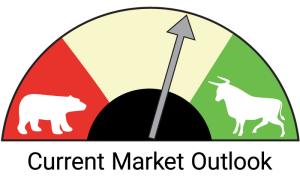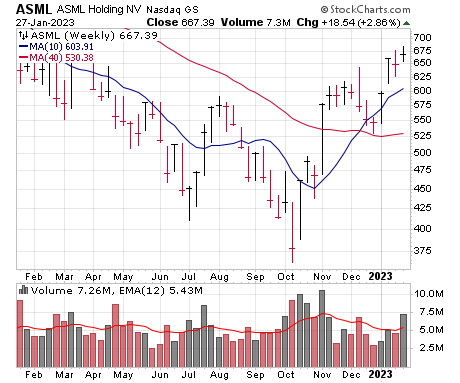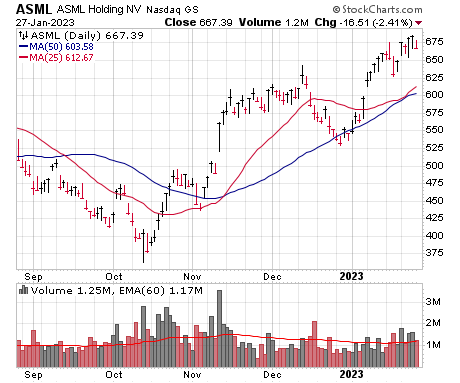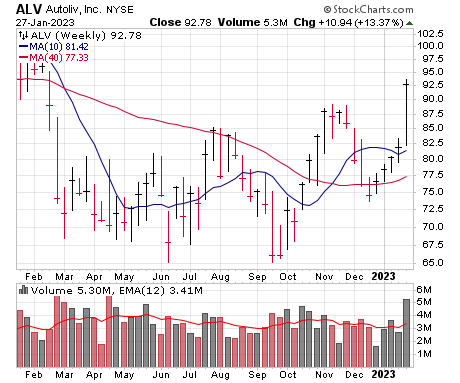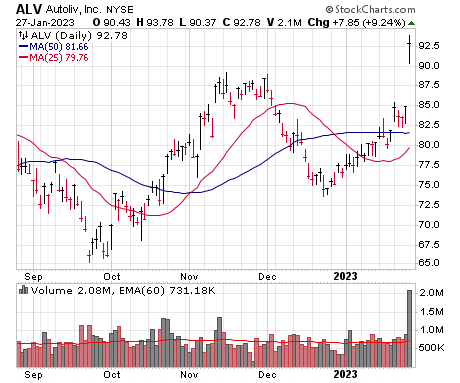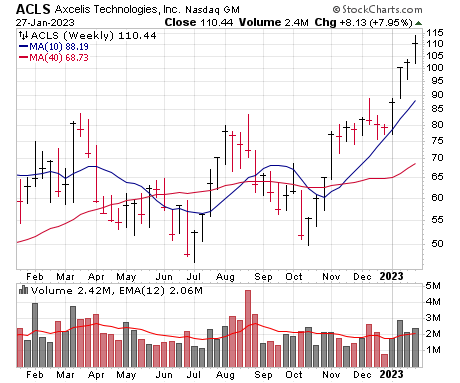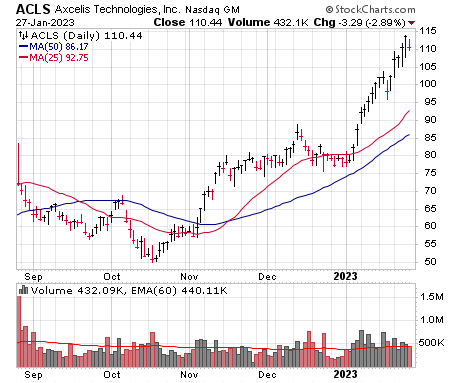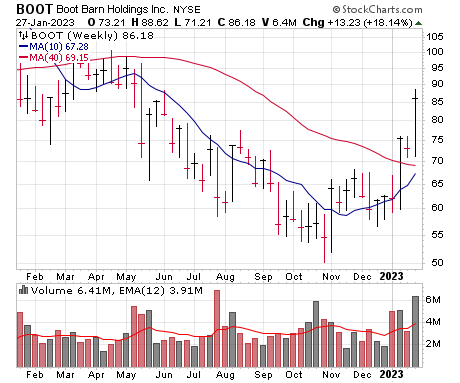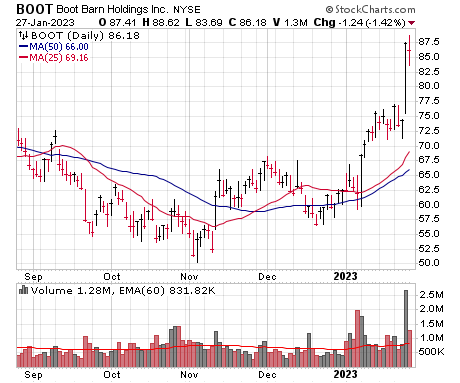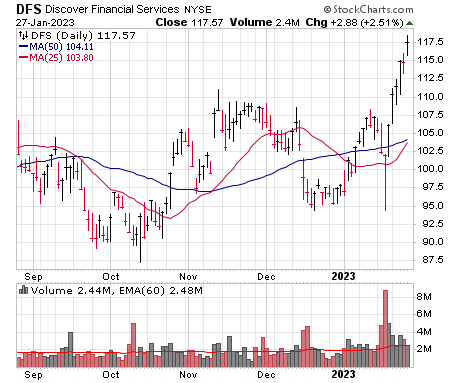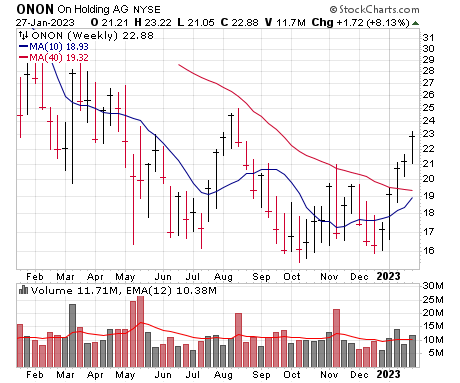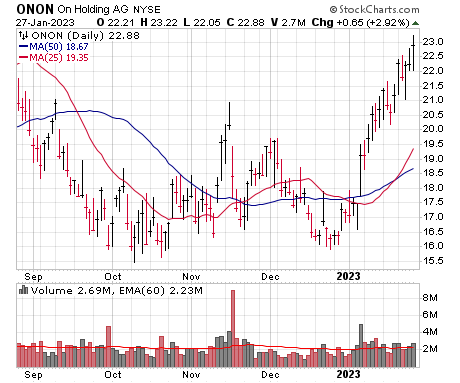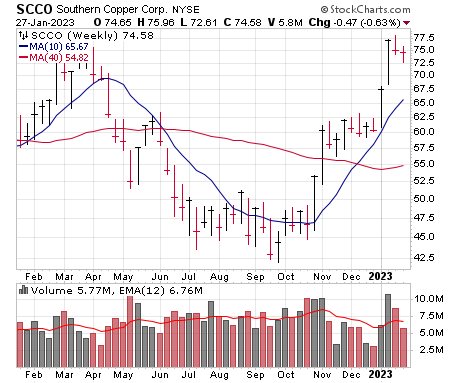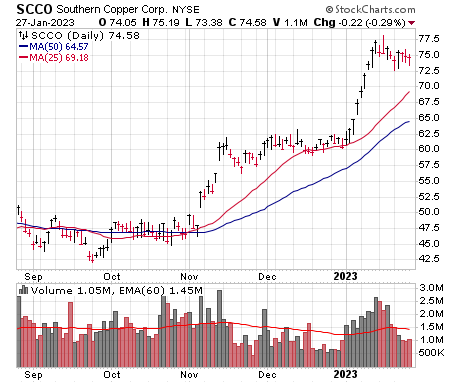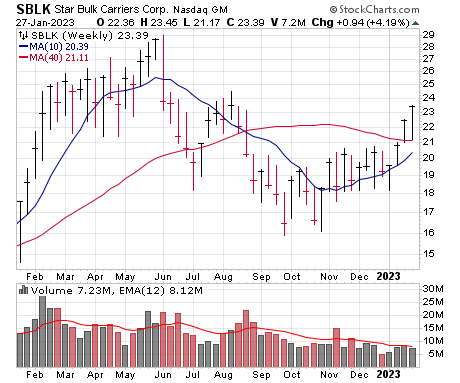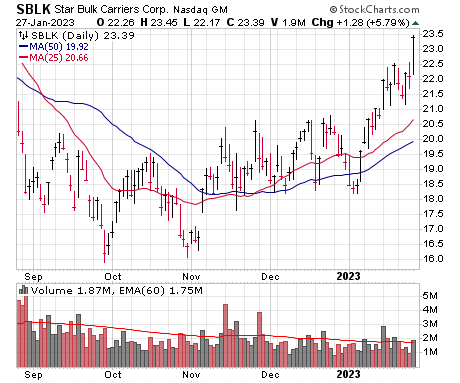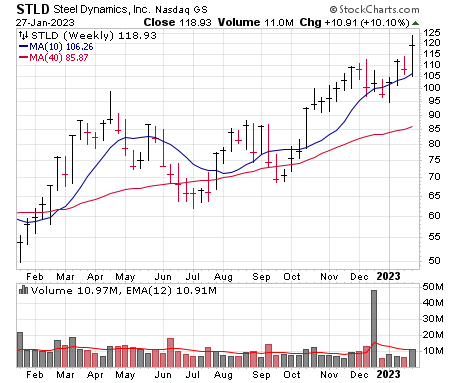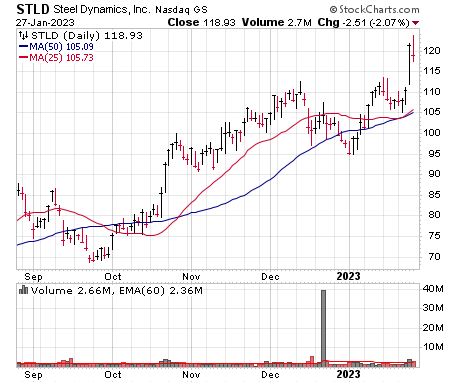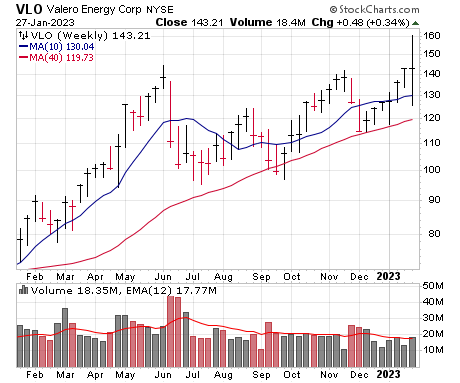Good So Far
If you’ve been expecting a straight-up advance with dozens of leaders lifting off, the past couple of weeks have been disappointing—but after the damage seen last year, we’re not going to make the perfect the enemy of the good: At this point, the intermediate-term trend is still sideways but a couple of good days could change that as many indexes are at/testing their December highs. Meanwhile, the longer-term trend could actually flip to positive dpending on how this week goes, and the broad market remains in fine shape despite some potholes of late (including today). Obviously, things can change (especially with big-cap earnings and the Fed this week) and we’re not advising you to cannonball into the market’s pool, but with the evidence continuing to crawl in the right direction, we’re nudging our Market Monitor up to a level 6 today.
This week’s list does have a few growth-ier ideas, but the majority remain cyclicals and recent earnings plays. Our Top Pick is Boot Barn (BOOT), a turnaround in the retail space that’s cheap-ish, has a long-term growth story and popped on earnings last week. Aim for dips.
| ASML Inc. (ASML) |
| Autoliv (ALV) |
| Axcelis Technologies (ACLS) |
| Boot Barn (BOOT) ★ Top Pick ★ |
| Discover Financial (DFS) |
| On Holding (ONON) |
| Southern Copper (SCCO) |
| Starbulk Carriers (SBLK) |
| Steel Dynamics (STLD) |
| Valero Energy (VLO) |
Stock 1
ASML Inc. (ASML)
Price | Buy Range | Loss Limit |
Why the Strength
Accelerating deliveries of its lithographic systems pushed ASML’s Q4 revenue to €6.4 billion (about $6.9 billion), in line with management’s improved forecast after Q3. Netherlands-based ASML makes equipment to etch nanometer-sized semiconductors using extreme ultraviolet (EUV) and deep ultraviolet (DUV) light. The company’s products are high-ticket items – selling for hundreds of millions of dollars apiece. Supply chain troubles from the pandemic and a White House-imposed prohibition on selling the equipment to China generated some headwinds in early 2022, but ASML is weathering them well. That’s because customers are seeing a potential chip slowdown in the first part of 2023 not lasting very long and therefore keeping their orders for the firm’s equipment in the queue. This year should also benefit from 2022 deferred revenue, when ASML elected to ‘fast ship’ equipment to customers without having completed all of its extensive quality control testing. Only once the systems are vetted at the customer site does ASML book the sale. This year, €3.1 billion of those deferred sales should hit the books, while the improved supply chain is largely eliminating the need to continue the quickened deliveries. This year, EUV and DUV growth will be around 25%, including deferred sales, even while global wafer equipment, which includes lower-end systems from other companies, declines due to weaker end-user demand. Things like 5G and continued evolution of high-end smart phones form Apple and Samsung feed into demand for ASML’s product line, and generate strong profit margins–after a modest dip last year, earnings are projected to lift by a third this year and another quarter in 2024.
Technical Analysis
ASML peaked with the technology sector in November 2021, and endured a long downtrend that took shares from 882 to 362 in 11 months. The snap back was huge late last year, and while ASML meandered for a bit in November and December, it held its 200-day line and came alive again as the calendar flipped. Shares have backed off a bit and we’re OK entering here, but further dips are possible should the market pull in.
| Market Cap | $265B | EPS $ Annual (Dec) | ||
| Forward P/E | 33 | FY 2020 | 10.36 | |
| Current P/E | 46 | FY 2021 | 16.30 | |
| Annual Revenue | $22.1B | FY 2022e | 14.26 | |
| Profit Margin | 28.2% | FY 2023e | 19.09 | |
| Qtrly Rev | Qtrly Rev Growth | Qtrly EPS | Qtrly EPS Growth | |
| ($B) | (vs. yr-ago-qtr) | ($) | (vs. yr-ago-qtr) | |
| Latest qtr | 6.88 | 21% | 4.92 | -1% |
| One qtr ago | 5.66 | -7% | 4.20 | -15% |
| Two qtrs ago | 5.69 | 19% | 3.71 | 24% |
| Three qtrs ago | 3.91 | -24% | 1.91 | -49% |
Weekly Chart | Daily Chart |
Stock 2
Autoliv (ALV)
Price | Buy Range | Loss Limit |
Why the Strength
Light vehicle production is expected to increase globally in 2023, along with safety features such as airbags, providing a nice tailwind for Autoliv. The Sweden-based company is a worldwide leader in automotive safety systems, producing airbags (it has a leading position in this market), seat belts and steering wheels for all major car manufacturers, as well as mobility safety solutions, such as pedestrian protection, connected safety services and safety products for motorcycle riders. About 20% of Autoliv’s sales are to China, with that country poised to become the world’s number two exporter of passenger vehicles, providing Autoliv with another tailwind. And the firm is stepping up into the EV trend, with many safety products (pyro fuses prevent battery systems from overcharging due to short circuits, which can cause fires) winning future contracts; importantly, around 45% of the firm’s order intake last year was from its various EV offerings. As for the here and now, the company announced that Q4 organic sales rose 18% from a year ago, as it outperformed in all regions. Adjusted operating margin rose to 10% of sales in Q4 (and up 7% for the full year), despite challenges related to cost inflation and a volatile auto market. Earnings jumped 41% to $1.83 per share, thanks in part to price increases, product launches and higher safety content per vehicle. Autoliv has also been slashing costs, recently implementing hundreds of cost efficiency projects, which it sees helping to mitigate inflation pressures. The top brass sees organic sales growth of around 15% in 2023 and expects positive cash flow trends will allow for higher shareholder returns. Wall Street shares the optimism and expects earnings to soar 50% for the full year after a modest dip in 2022.
Technical Analysis
ALV was hit by last year’s soft global auto environment and, of course, the bear market, shedding nearly 40% from January through September (though most of the damage was done by March). October saw a change in fortune for the stock, as ALV climbed from 66 to 90 over an eight-week period. There was a dip in December, but shares established a higher low and now ALV has lifted five weeks in a row, capped by last Friday’s earnings gap to multi-month highs. We’re OK taking a swing at the stock here or (preferably) on dips.
| Market Cap | $8.06B | EPS $ Annual (Dec) | ||
| Forward P/E | 14 | FY 2021 | 5.01 | |
| Current P/E | 19 | FY 2022 | 4.40 | |
| Annual Revenue | $8.84B | FY 2023e | 6.45 | |
| Profit Margin | 6.8% | FY 2024e | 8.84 | |
| Qtrly Rev | Qtrly Rev Growth | Qtrly EPS | Qtrly EPS Growth | |
| ($B) | (vs. yr-ago-qtr) | ($) | (vs. yr-ago-qtr) | |
| Latest qtr | 2.34 | 10% | 1.83 | 41% |
| One qtr ago | 2.30 | 25% | 1.23 | 68% |
| Two qtrs ago | 2.08 | 3% | 0.90 | -25% |
| Three qtrs ago | 2.12 | -5% | 0.46 | -74% |
Weekly Chart | Daily Chart |
Stock 3
Axcelis Technologies (ACLS)
Price | Buy Range | Loss Limit |
Why the Strength
Axcelis announced very bullish preliminary results for its Q4 earlier this month as demand for its semiconductor wafer fabrication equipment generated revenue of more than $250 million, some 12% better than previous guidance. Earnings per share will be around $1.45, too, also besting the consensus of $1.10. The strong quarter pushes full year sales over $900 million with a bottom line of $5 per share, with the growth and upside surprises standing in contrast to most of the semiconductor industry, which is seeing weakness in response to softening consumer demand for electronics. Axcelis says semiconductor makers have been ordering plenty of its Purion line of ion implanters, which is used to control impurities and direct the fabrication of wafers. The electrification of the automobile is helping business, since EV chips have higher quality demands around heat and resiliency than what goes into chip made for, say, an appliance or TV. Axcelis is seeing good interest from makers of silicon carbide (SiC) chips, too. SiC is a small but rapidly-growing segment of the chip market, and is expected to boom for many more years given SiC’s superior performance with high voltages, the kind required in EVs and renewable energy. Higher-end silicon chip and SiC makers like the Purion line’s precision and ability to limit manufacturing defects, and that’s a reason why management expects growth in 2023, while competitors are retrenching. Manufacturers in China are Axcelis’ biggest business, about 45% of sales, but management says the recent federal ban on selling sensitive semiconductor manufacturing technology into the country doesn’t apply to the Axcelis, which is obviously a plus business-wise. The official Q4 release will come February 8.
Technical Analysis
Early January’s preliminary Q4 results busted ACLS out of a year-long range of 50 to 85, with 13 of the 16 days after the announcement seeing shares close higher, and on big volume, too. (We like that the move came after some tightness in the 75 to 80 area in November and December, a sign of accumulation.) The initial thrust out of a major base is certainly encouraging; if you want in, we advise looking for dips of a few points ahead of earnings.
| Market Cap | $3.63B | EPS $ Annual (Dec) | ||
| Forward P/E | 21 | FY 2020 | 1.46 | |
| Current P/E | 24 | FY 2021 | 2.88 | |
| Annual Revenue | $860M | FY 2022e | 5.16 | |
| Profit Margin | 17.6% | FY 2023e | 5.45 | |
| Qtrly Rev | Qtrly Rev Growth | Qtrly EPS | Qtrly EPS Growth | |
| ($M) | (vs. yr-ago-qtr) | ($) | (vs. yr-ago-qtr) | |
| Latest qtr | 229 | 30% | 1.21 | 49% |
| One qtr ago | 221 | 50% | 1.32 | 140% |
| Two qtrs ago | 204 | 53% | 1.22 | 154% |
| Three qtrs ago | 206 | 68% | 1.05 | 144% |
Weekly Chart | Daily Chart |
Stock 4
Boot Barn (BOOT) ★ Top Pick ★
Price | Buy Range | Loss Limit |
Why the Strength
Boot Barn is a lifestyle retailer with over 330 stores across 38 states, specializing in Western apparel, including boots, hats and clothing for customers of both sexes and all ages. Customer loyalty is a big part of the growth story for Boot Barn, as its total active customer count has surged an eye-opening 70%, to almost seven million in just the last three years, with many of those coming back again and again: A recent survey found that 81% of those who made their first purchase at the store after the start of the pandemic plan to make another purchase this year. This has encouraged the company to embark on a major expansion initiative, which it believes can increase store count to around 900 in the coming years (up from 333 at year-end) based on the customer acquisition numbers. On the financial front, results were mixed in last week’s earnings report. Boot Barn saw net sales increase 6% from a year ago in fiscal Q3, thanks to new store openings (it opened 33 last year, an 11% increase in the base) and higher average unit prices. But same-store sales dipped 4% with even e-commerce sales losing ground (down 15%), and per-share earnings of $1.77 were 13% lower, mainly due to margins being squeezed by higher freight costs. However, the stock is strong because most of these issues look to be nearly through the system—Boot Barn expects a stronger Q4 with inflation pressures expected to abate, and it guided for 10 new store openings in the quarter, keeping that part of the story intact. Boot Barn also guided for a 16% revenue increase in the current quarter, and management said its growth opportunities “remain as strong as ever” thanks to “very successful” recent store openings and a “robust” new store pipeline. Analysts see a gradual return to earnings growth, and the modest valuation (16x trailing earnings) should keep investors interested as the positives take hold.
Technical Analysis
BOOT enjoyed a great uptrend for nearly two years, kiting as high as 120 in December 2021. The peak was followed by a seven-month hangover that shaved nearly 60% off the price, ending in early November at 50. Two more months of bottoming followed, with BOOT making a higher low last month, before the New Year saw the blossoming of a new uptrend with shares catapulting above the 40-week line initially, and then following through after earnings last week. A normal exhale here should be buyable.
| Market Cap | $2.57B | EPS $ Annual (Mar) | ||
| Forward P/E | 14 | FY 2021 | 1.93 | |
| Current P/E | 16 | FY 2022 | 6.18 | |
| Annual Revenue | $1.62B | FY 2023e | 5.55 | |
| Profit Margin | 10.3% | FY 2024e | 6.00 | |
| Qtrly Rev | Qtrly Rev Growth | Qtrly EPS | Qtrly EPS Growth | |
| ($M) | (vs. yr-ago-qtr) | ($) | (vs. yr-ago-qtr) | |
| Latest qtr | 515 | 6% | 1.77 | -21% |
| One qtr ago | 352 | 12% | 1.06 | -13% |
| Two qtrs ago | 366 | 19% | 1.26 | 0% |
| Three qtrs ago | 383 | 48% | 1.47 | 96% |
Weekly Chart | Daily Chart |
Stock 5
Discover Financial (DFS)
Price | Buy Range | Loss Limit |
Why the Strength
The economy is set to slow (early indications are for sub-1% GDP this quarter) and the Fed has made money more expensive, and that’s usually a bad thing for credit card and lending outfits like Discover—and, fundamentally, we’re seeing some of that in the numbers. While Q4’s top line (net of interest expense) lifted 27%, the so-called charge-off rate (bad loans) soared to 2.13% (up from 1.37% a year ago), while the 30-day delinquency rate for its credit cards was 2.53% (up from 2.11% the prior quarter!), all of which kept earnings in check—and Discover’s view that the rate should rise into the upper 3% range this year has Wall Street looking for a bottom line drop in 2023 despite loan growth expected in the low double digits. Still, after an initial shakeout, the stock has lifted to multi-month highs for a couple of reasons. First, there’s the macro environment, with hopes of a soft landing, a still-solid job market and under-control market-based rates all likely to keep the consumer in relatively good shape. Second is perspective: Charge-off rates are rising, but are “only” rising back to levels seen pre-pandemic; indeed, Discover’s pre-pandemic earnings summit was $9.08 in 2019, but now $13 looks “low.” Throw in some similar outlooks from peers like American Express and Capital One and buyers are thinking last year’s decline and the tame valuations (7x trailing earnings here, 2.0% dividend yield, Discover bought back $2.4 billion of stock last year) discounted the worst of whatever downturn materializes this year. As far as credit card firms go, we think there’s solid potential if the market hangs in there.
Technical Analysis
DFS peaked in August 2021 and steadily lost ground as the market weakened and the Fed tightened, falling about 35% to its nadir in June and successfully retesting that area in September/October. The rally from there wasn’t anything exciting, with DFS still battling with its 40-week line, and it looked done for after earnings, but the initial dip was met with a wave of buying, with shares popping since then. A bit more weakness would be tempting.
| Market Cap | $32.1B | EPS $ Annual (Dec) | ||
| Forward P/E | 9 | FY 2021 | 9.08 | |
| Current P/E | 7 | FY 2022 | 3.60 | |
| Annual Revenue | $15.2B | FY 2023e | 13.41 | |
| Profit Margin | 22.8% | FY 2024e | 11.86 | |
| Qtrly Rev | Qtrly Rev Growth | Qtrly EPS | Qtrly EPS Growth | |
| ($B) | (vs. yr-ago-qtr) | ($) | (vs. yr-ago-qtr) | |
| Latest qtr | 4.52 | 42% | 3.77 | 4% |
| One qtr ago | 3.99 | 31% | 3.54 | 0% |
| Two qtrs ago | 3.53 | -9% | 3.96 | -29% |
| Three qtrs ago | 3.16 | 2% | 4.22 | -16% |
Weekly Chart | Daily Chart |
Stock 6
On Holding (ONON)
Price | Buy Range | Loss Limit |
Why the Strength
On has a great story of innovation when it comes to shoes—the Swiss firm’s offerings give runners (and, increasingly, many other athletes, including tennis) more support, a softer cushion when landing and a bit more “spring” when pushing off the ground. That and natural expansion into things like trail running, hiking and even apparel, as well as premium pricing ($130 to $180 for a pair), has helped the firm take market share in a big way: From its founding in 2010, On likely cranked out $1.25 billion in revenue last year with rapid growth still in place. However, there’s upside beyond that, as On could be the next Lululemon in a sense: While the products are different, the company is benefiting from its offerings being adopted for everyday use because of both comfort and style, similar to how Lululemon’s yoga wear was a big factor in the adoption of athleisure apparel. It’s hard to quantify, but it’s easy to see if you look around higher-end areas, and usually once these trends are in effect for a new brand, they continue for many years assuming management makes the right moves. Back to the business, things were actually hampered a bit early last year because of supply chain issues, but that’s in the past and, while there hasn’t been any official pre-announcement, the top brass sounded an optimistic tone on demand trends in an early-January conference. The bottom line has been in the black for a while, and analysts see the top line lifting 35% or so this year while earnings leap 27%, both of which are likely conservative. Granted, the valuation is up there, but On has the potential to be one of the next big, high-end consumer brands.
Technical Analysis
ONON came public in late 2021, spiked a few weeks later and then had a giant post-IPO selloff as the bear market crushed valuations—shares dipped from above 50 to around 16 in March and again in May. Interestingly, though, that was effectively the bottom, with multiple retests and holds of the 16 area in the months that followed, and ONON has been pushing higher on good volume since the year flipped, capturing its 40-week line and continuing higher. A dip of a point or two would be tempting.
| Market Cap | $15.0B | EPS $ Annual (Dec) | ||
| Forward P/E | 60 | FY 2020 | -0.05 | |
| Current P/E | N/A | FY 2021 | -0.60 | |
| Annual Revenue | $1.10B | FY 2022e | 0.30 | |
| Profit Margin | 6.1% | FY 2023e | 0.38 | |
| Qtrly Rev | Qtrly Rev Growth | Qtrly EPS | Qtrly EPS Growth | |
| ($M) | (vs. yr-ago-qtr) | ($) | (vs. yr-ago-qtr) | |
| Latest qtr | 332 | 42% | 0.07 | 250% |
| One qtr ago | 305 | 61% | 0.15 | 650% |
| Two qtrs ago | 255 | 72% | 0.05 | 150% |
| Three qtrs ago | 210 | 49% | -0.66 | N/A |
Weekly Chart | Daily Chart |
Stock 7
Southern Copper (SCCO)
Price | Buy Range | Loss Limit |
Why the Strength
Southern Copper is a leading miner, smelter and refiner of copper, molybdenum, silver and zinc, with most of its most of its mining operations in Mexico and Peru and exploration activities in Argentina, Chile and Ecuador. Copper represents around 80% of Southern’s sales, and the firm is the world’s fifth largest copper producer with the biggest reserves and longest combined mine life of all major producers. A combination of a weaker U.S. dollar (in which copper is priced worldwide) and China’s reopening has resulted in higher prices for the red metal—up 30% since bottoming last September—and this is a big part of what’s driving Southern’s strength. As the world’s largest copper consumer at over 50% of global production, China’s industrial demand for the metal is expected to soar this year (indeed, Chinese imports of copper concentrate are up over 9% in January). Moreover, U.S. demand should be strong thanks in part to many Congressional bills passed in recent years—the U.S. Infrastructure Act should help construction activity, the green energy bill should boost demand for things like renewable power generation, transmission lines and electric vehicle charger networks that use copper, while the CHIPS & Science Act will allocate spending for new semiconductor facilities that require lots of copper-based electrical infrastructure. All of that should provide Southern with a tailwind for years to come. On the financial front, Southern saw its Q3 revenue decline 20% from a year ago while per-share earnings of 67 cents were 40% lower (but 24% above estimates). The weaker performance was attributable to a drop in copper prices from the prior year, plus higher production costs. But with copper prices rebounding and the company’s copper production increasing (Q3 was up 11% from Q2), analysts expect revenue to jump 16% sequentially when the company reports Q4 earnings (no set date yet).
Technical Analysis
SCCO hit a highwater mark of 83 in May 2021—almost a year before the price of copper peaked—and almost made it back to that summit last April before the bear got its claws into the stock, with shares sinking to 47 in July. That effectively started a bottoming process, though, with SCCO meandering sideways for months (with one brief poke to a new low in September) before changing character for the better after Q3 earnings. The early-year rush higher on huge volume is very encouraging; minor weakness should be buyable.
| Market Cap | $57.7B | EPS $ Annual (Dec) | ||
| Forward P/E | 23 | FY 2020 | 2.03 | |
| Current P/E | 22 | FY 2021 | 4.39 | |
| Annual Revenue | $10.1B | FY 2022e | 3.13 | |
| Profit Margin | 24.1% | FY 2023e | 3.20 | |
| Qtrly Rev | Qtrly Rev Growth | Qtrly EPS | Qtrly EPS Growth | |
| ($B) | (vs. yr-ago-qtr) | ($) | (vs. yr-ago-qtr) | |
| Latest qtr | 2.16 | -20% | 0.67 | -40% |
| One qtr ago | 2.31 | -20% | 0.56 | -54% |
| Two qtrs ago | 2.76 | 9% | 1.02 | 3% |
| Three qtrs ago | 2.82 | 20% | 1.08 | 42% |
Weekly Chart | Daily Chart |
Stock 8
Starbulk Carriers (SBLK)
Price | Buy Range | Loss Limit |
Why the Strength
Starbulk Carriers is one of the largest drybulk carriers in the world with 128 carriers of all shapes and sizes, and business here has almost surely peaked—drybulk (and all other) shipping rates have come down meaningfully, which is why earnings estimates for 2023 are currently calling for a 37% fall. So why is the stock perking up? A few reasons. First, even with the expected slowdown, Starbulk should be gushing cash; the firm has very low costs (just $5,700 per day, per vessel), so even should rates fall, you’re talking huge margins here. Second, Starbulk’s innovative dividend policy—it keeps $2.1 million in cash for every vessel it has as cushion, and pays out the rest—has produced both a big decrease in net debt (down 43% from three years ago; no debt maturities until 2024) and massive dividends that totaled $6.50 per share last year! That total will obviously come down a lot, but with few drydocking expenses coming up, big percentage payouts are still likely. Third, there’s China’s reopening, which is expected to help business (iron ore shipments were soft last year, but as China’s steel production ramps, that should change), and fourth is the bullish long-term view: Drybulk carrier fleet growth was just 2.8% last year, and that figure is likely to drop under 2% both this year and next as the orderbook is near multi-decade lows; that should keep a floor under rates and/or allow them to percolate should the global economy remain afloat. Don’t get us wrong, the industry is still as cyclical as can be, but it’s looking like the downturn in the sector will be much milder than past years—with a new upturn not out of the question, either, should China’s demand come in hot.
Technical Analysis
SBLK rallied beautifully into mid 2021, and after a few months of rest, popped higher in early 2022, finally peaking near 29 in June. The retreat after that wasn’t mild; shares dipped as much as 45% in just four months, and even after a quick double bottom near 16, shares were still languishing under 20 (and most moving averages) heading into year-end. But the new year has brought new buying, with shares up four weeks in a row, albeit on modest volume. There is overhead up here, so if you want in, nibbling on a pullback is advised.
| Market Cap | $2.39B | EPS $ Annual (Dec) | ||
| Forward P/E | 6 | FY 2020 | 0.17 | |
| Current P/E | 3 | FY 2021 | 6.82 | |
| Annual Revenue | $1.64B | FY 2022e | 5.75 | |
| Profit Margin | 37.4% | FY 2023e | 3.61 | |
| Qtrly Rev | Qtrly Rev Growth | Qtrly EPS | Qtrly EPS Growth | |
| ($M) | (vs. yr-ago-qtr) | ($) | (vs. yr-ago-qtr) | |
| Latest qtr | 364 | -12% | 1.33 | -39% |
| One qtr ago | 417 | 34% | 2.00 | 59% |
| Two qtrs ago | 361 | 80% | 1.72 | 378% |
| Three qtrs ago | 500 | 169% | 2.96 | 887% |
Weekly Chart | Daily Chart |
Stock 9
Steel Dynamics (STLD)
Price | Buy Range | Loss Limit |
Why the Strength
China’s battered real estate is primed for a comeback this year as its government plans to fiscally stimulate the sector, and that’s welcome news for steel makers (with China being the biggest buyer in the global industry). Steel Dynamics is America’s third largest producer of carbon steel, which is used in buildings, bridges, rails, pipelines and other infrastructure, and the company should benefit from China’s return to growth. Last week was a strong one for Steel Dynamics after it reported blowout Q4 results and offered an optimistic industry outlook. While revenue was 9% lower from a year ago, it topped estimates by 14% and per-share earnings of $4.37 beat expectations by a whopping 61 cents. The company also set records across several metrics, including adjusted EBITDA of $5.5 billion (up 20%). Steel fabrication earnings and shipments also set records, and the firm notched another milestone during the quarter in being added to the S&P 500. More important is the future, and the top brass is relatively sanguine: Customer order activity remains “healthy” across the business, while steel pricing has firmed and order activity and backlogs remain “solid.” Steel Dynamics believes North American steel consumption will increase in 2023 and sees continent-wide automotive production rising to around 15 million units this year (up 7% if realized). Also helping the 2023 cause is that the company repurchased 12% of its shares last year while increasing liquidity to a record $3.4 billion as of December 31. Going forward, Steel Dynamics is ramping operations at its new state-of-the-art electric arc furnace flat rolled steel mill in Texas, with four value-added flat rolled steel coating lines expected to begin in the second half of 2023. Analysts see earnings falling this year, but (a) even at the $11 per share that’s expected, it would be more than twice the pre-pandemic peak in earnings, and (b) China’s reopening could easily make that figure prove conservative.
Technical Analysis
Steel stocks took a dive after peaking last April along with steel prices, as China’s weaker economy and the prospect for super-strict lockdowns took a toll. But STLD managed to outperform its peers throughout the year, initially taking a 30% hit into July but then moving up from there; there was a higher low in September and then a rush to all-time highs in early December. After a modest four-week dip, STLD took off again, with last week’s move notching new highs. We like the action but favor looking for dips if you want in.
| Market Cap | $20.9B | EPS $ Annual (Dec) | ||
| Forward P/E | 10 | FY 2021 | 16.24 | |
| Current P/E | 5 | FY 2022 | 22.68 | |
| Annual Revenue | $22.3B | FY 2023e | 11.35 | |
| Profit Margin | 15.9% | FY 2024e | 8.14 | |
| Qtrly Rev | Qtrly Rev Growth | Qtrly EPS | Qtrly EPS Growth | |
| ($B) | (vs. yr-ago-qtr) | ($) | (vs. yr-ago-qtr) | |
| Latest qtr | 4.83 | -9% | 4.37 | -24% |
| One qtr ago | 5.65 | 11% | 5.46 | 10% |
| Two qtrs ago | 6.21 | 39% | 6.73 | 98% |
| Three qtrs ago | 5.57 | 57% | 6.02 | 187% |
Weekly Chart | Daily Chart |
Stock 10
Valero Energy (VLO)
Price | Buy Range | Loss Limit |
Why the Strength
Valero is the world’s largest independent oil refiner and (through a subsidiary) the second-largest corn ethanol and renewable biodiesel producer, making it a major player in both the oil/gas and clean energy spaces. After a multi-month setback in 2022, global oil demand is expected to rebound this year on the back of China’s reopening. Valero, meanwhile, has just completed a number of expansion projects that should allow it to take full advantage of an anticipated rebound in both the traditional and renewable fuel markets. Enhancing Valero’s outlook is a scheduled February 5 ban on Russian oil products by Europe, which could boost gasoline and diesel prices even further (both prices started to rise again in late December). In view of these factors, Valero sees low product inventories across the sector and a continued increase in product demand in the coming months, which it believes will keep refining margins elevated. In Q4, Valero’s crude oil refineries operated at a 97% capacity utilization rate—the highest in four years—while margins more than doubled from a year ago. Valero smashed estimates in the quarter, with revenue rising 16% from a year ago, while EPS of $8.45 beat estimates by 15%, contributing to a $4 billion debt reduction and easily supporting the dividend (2.7% annual yield). Looking ahead, Valero will begin the startup of a new coker at its Port Arthur refinery in Texas in Q2, while the firm’s renewable diesel segment should benefit from a project that just went live, adding an incremental 470 million gallons of annual diesel capacity. The company expects these and other investments to add around $1.4 billion to its annual EBITDA capacity. That’s one reason that, despite a projected decline in earnings, the bottom line is expected to remain in the stratosphere compared to the firm’s pre-2020 earnings peak of $7.35 per share.
Technical Analysis
VLO went sideways for a year starting in March 2021 before taking off again in the middle of last year, shooting as high as 147 last June. That led to another long, seven-plus-month rest, but now VLO is perking up—shares have risen seven weeks in a row and are testing new high ground last week. (Ignore the big spike last Tuesday; that was part of the NYSE glitch.) As is par for the course, shares are hesitating as they approach virgin turf, so we advise aiming for weakness if you want in.
| Market Cap | $55.2B | EPS $ Annual (Dec) | ||
| Forward P/E | 7 | FY 2021 | 2.81 | |
| Current P/E | 5 | FY 2022 | 29.16 | |
| Annual Revenue | $176B | FY 2023e | 21.26 | |
| Profit Margin | 7.7% | FY 2024e | 14.97 | |
| Qtrly Rev | Qtrly Rev Growth | Qtrly EPS | Qtrly EPS Growth | |
| ($B) | (vs. yr-ago-qtr) | ($) | (vs. yr-ago-qtr) | |
| Latest qtr | 41.7 | 16% | 8.45 | 251% |
| One qtr ago | 44.5 | 51% | 7.14 | 437% |
| Two qtrs ago | 51.6 | 86% | 11.36 | 999% |
| Three qtrs ago | 38.5 | 85% | 2.31 | N/A |
Weekly Chart | Daily Chart |
Previously Recommended Stocks
| Date | Stock | Symbol | Top Pick | Original Buy Range | 1/30/23 |
| HOLD | |||||
| 1/23/23 | Abercrombie & Fitch | ANF | 26-27.5 | 28 | |
| 9/12/22 | ★ | 48.5-51.5 | 57 | ||
| 1/3/23 | 47-49 | 49 | |||
| 1/23/23 | Alpha Metallurgical | AMR | ★ | 161-165 | 164 |
| 1/17/23 | ★ | 16.3-17.3 | 16 | ||
| 1/17/23 | 21.5-23 | 21 | |||
| 10/24/22 | 133-136 | 192 | |||
| 12/5/22 | ★ | 101-105 | 115 | ||
| 1/23/23 | Boeing | BA | 200-205 | 210 | |
| 12/5/22 | 106-111 | 98 | |||
| 1/3/23 | 49.5-51.5 | 51 | |||
| 1/17/23 | 53-54.5 | 54 | |||
| 1/17/23 | 63-65.5 | 66 | |||
| 1/17/23 | 170-175 | 171 | |||
| 11/7/22 | 145-150 | 194 | |||
| 1/3/23 | 39.5-41 | 44 | |||
| 1/17/23 | 102-105 | 109 | |||
| 11/7/22 | 101-104 | 125 | |||
| 1/23/23 | Inspire Medical | INSP | 247-254 | 251 | |
| 1/17/23 | Jabil Inc. | JBL | 74.5-77 | 77 | |
| 1/9/23 | JD.com | 59.5-62 | 60 | ||
| 1/17/23 | 92.5-95 | 96 | |||
| 1/3/23 | 31.5-33.5 | 36 | |||
| 1/23/23 | Noble Corp. | NE | 39-40.5 | 40 | |
| 1/9/23 | ★ | 218-226 | 250 | ||
| 12/19/22 | 73.5-75.5 | 83 | |||
| 1/9/23 | 211-215 | 223 | |||
| 1/17/23 | 55-57 | 56 | |||
| 11/21/22 | 44-46 | 62 | |||
| 1/23/23 | Toll Brothers | TOL | 53-55 | 57 | |
| 1/23/23 | United Airlines | UAL | 47.5-50 | 48 | |
| 1/3/23 | 45-46.5 | 55 | |||
| 8/22/22 | 115-120 | 157 | |||
| 12/5/22 | 81-84 | 100 | |||
| 1/17/23 | 59.5-61 | 61 | |||
| 1/23/23 | Zillow | Z | 41.5-43 | 44 | |
| WAIT | |||||
| 1/23/23 | Agnico Eagle | AEM | 54-55.5 | 56 | |
| SELL RECOMMENDATIONS | |||||
| 12/12/22 | 116-120 | 128 | |||
| 1/9/23 | 60-62.5 | 60 | |||
| 11/21/22 | 330-342 | 431 | |||
| 12/19/22 | Univar | UNVR | 31.5-33.5 | 34 | |
| DROPPED | |||||
The next Cabot Top Ten Trader issue will be published on February 6, 2023.

